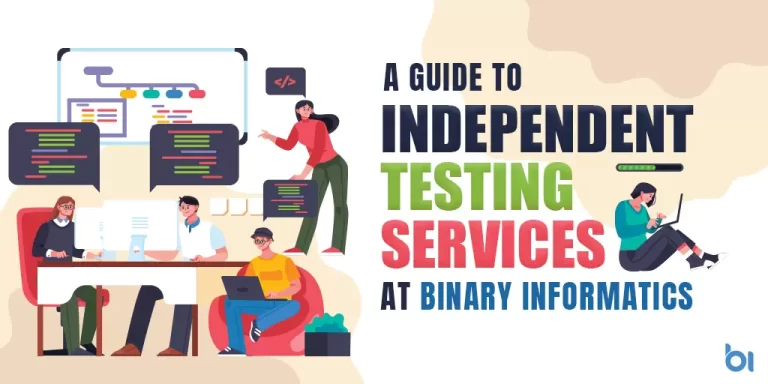Technology has revolutionized faster in almost every industry, and the insurance industry is no exception. Some of the most radical and exciting have been the developments in advanced AI systems used to generate the human-like analysis and outputs. Imagine a time when an insurer predicts perils with pinpoint accuracy, customizes policies that fit every individual customer, and processes claims at record times. This is by no means a hypothetical assumption; indeed, Generative AI Solutions for Insurance are being realized and, with great impact, are influencing and changing the functions of insurance.
Unlike a human analyst, AI algorithms can plow through huge amounts of data in a flash to find insights no human could hope to find. One-size-fits-all insurance policies are rapidly going by the wayside, while customized coverage is tuned almost on the fly to the specific situation of the policyholder and their needs. Come, join us to explore the potential of the latest AI solutions in bringing transformation to insurance, where accessing risks has become a refined science and customer satisfaction is high. Step into a future where “Generative AI Solutions for Insurance” is not just another buzzword in the industry but one game-changer in the long list of game-changing innovative disruptions that the paramount sector is going through right now.
According to the Precedence Statistics, The global generative AI in insurance market size was estimated at USD 462.11 million in 2022 and it is expected to hit around USD 8,099.97 million by 2032, growing at a CAGR of 33.11% during the forecast period from 2023 to 2032.

Table of Contents
ToggleGenerative AI in Insurance: An Overview
Advanced AI systems, sometimes also referred to as generative AI solutions, may provide the possibilities for the insurance world to turn into a brighter side, enabling automation of routine tasks, improving customer experience, and lowering risks. In this regard, powerful AI technology is an inevitable thing for any insurance company in the present cut-throat competitive environment, wherein the customers’ needs are ever-evolving.
Among the field where AI is stepping in, automating underwriting to assess the risk and even set the pricing is one of the major fields. Moreover, AI, with advanced algorithms and available data, is able to assess the risk much better than human apprehension will allow; in this way, companies will make better decisions.
AI is also changing the way companies handle claims. The system does this by going through massive pools of data, aided by real-time analytics, to bust every false claim, speed up the process of legitimate ones, and ultimately gain improvement in customer service.
Personalization is the second way in which Generative AI Solutions for Insurance is totally changing the insurance game. “They say, as part of a personal understanding of all their customers’ tastes and behaviors, insurance companies design marketing campaigns and offerings of products specifically, often only for an individual.
In addition, AI greatly helps in the improvement of how businesses manage risks across the whole firm. Potential risks could be identified in advance, which might allow taking preventive actions to minimize loss and optimize the overall risk portfolio.
Generative AI Use Cases in Insurance Industry
The insurance industry is exploring various use cases of generative AI, which can bring significant benefits and transformative potential. Here are some notable applications:
- Claim Processing Automation: Generative AI models can analyze claim documents, extract relevant information, and generate initial claim reports or summaries, streamlining the claim processing workflow and reducing manual effort.
- Policy Generation: Generative AI models can be trained on existing policy documents and generate customized policy drafts based on customer requirements, reducing the time and effort required for policy creation and tailoring.
- Risk Assessment and Underwriting: AI models can analyze vast amounts of data, including historical claims, customer profiles, and external data sources, to assess risks more accurately and generate personalized risk scores or pricing recommendations.
- Customer Service and Communication: Generative AI can be used to generate personalized communication materials, such as policy explanations, claim status updates, or marketing materials, tailoring the language and tone to individual customers.
- Fraud Detection: AI models can be trained to identify patterns and anomalies in claims data, generating alerts or reports for potential fraudulent activities, helping insurance companies mitigate risks and losses.
- Predictive Maintenance and Risk Mitigation: In industries like automotive or property insurance, generative AI can analyze sensor data, images, or other relevant information to predict potential failures or risks, enabling proactive maintenance or risk mitigation strategies.
- Product Development and Innovation: Generative AI can assist in ideating new insurance products or services by analyzing customer feedback, market trends, and generating novel product concepts or features.
- Data Augmentation and Synthetic Data Generation: Generative AI models can be used to create synthetic data, such as simulated claim scenarios or customer profiles, which can be used to enhance existing datasets for training other AI models or testing hypothetical situations.
- Personalized Marketing and Recommendation Systems: Generative AI can analyze customer data and generate personalized marketing messages, product recommendations, or targeted offers, improving customer engagement and retention.
It’s important to note that the adoption of generative AI in the insurance industry must be accompanied by robust governance frameworks, ethical considerations, and regulatory compliance to ensure responsible and trustworthy use of these technologies.
Challenges and limitations of generative AI technology in Insurance sector and how to overcome
Generative AI technology, like large language models and generative adversarial networks (GANs), opens opportunities, but it also presents challenges to the insurance sector. Highlighted herein are some of the probable challenges and constraints listed down with the suggestions for each one of them for overcoming the same:
#1 Data Privacy and Security
==> Challenge: Generative AI models require huge datasets for training, which involves policyholders’ sensitive personal and financial information. Hence, there has to be a data privacy and security mechanism in place.
==> Mitigation: Follow best practices using data governance with strong techniques in place for anonymizing the data governed. Always ensure adherence to very strict data privacy regulations and obtain proper consent from the policyholders for the use of data.
#2 Bias and Fairness
==> Challenge: A possible concern, in this respect, has arisen due to the fact that the generative AI models can inherit biases from the training data, leading to discriminatory outcomes in, for example, underwriting, claims processing, or customer service.
==> Mitigation: This includes techniques like debiasing algorithms, data augmentation, and diversity in data sourcing, which is done in the training set so that there is no bias. Regular audit and monitoring could be done for checking the model and its predictions to be unbiased and non-discriminative.
#3 Interpretability and Explainability
==> Challenging: Most of the generative AI models, especially deep learning ones, output results that are hardly transparent and interpretable, which may present a challenge in explanation toward regulators, auditors, or even customers at times.
==> Mitigation: Development of models of very high interpretability or the use of post-hoc explainability approaches, like SHAP or LIME, while adhering to regulatory guidelines of model governance and explainability.
#4 Robustness and Adversarial Attacks
==> Challenge: Generative AI models are prone to adversarial attacks, where small differences in input data lead to outcomes other than those expected or even become a menace.
==> Mitigation: Develop strong training mechanisms that include adversarial training and data augmentation in order to ensure better resilience of the model. Continuously monitor the models and refine them in such a way that if there could be any possible attacks, it shall be detected and ameliorated.
#5 Integration with Legacy Systems
==> Challenge: Integrating the generative AI models into the existing systems, processes, workflows, and way of doing things traditionally within the insurance firm will be quite complex and may pose a high change magnitude.
==> Mitigation: The integrative approach should be phased and iterative, where pilot projects come first, while closely working with the cross-functional team from IT, Operations, and Compliance.
#6 Regulatory Compliance
==> Challenge: The insurance industry is subject to very good regulation. Many regulative environments will apply to a generative AI model, to include but not be limited to model risk management, fair lending practices, and consumer protection laws.
==> Mitigation: Should continue and keep updating in accordance with the stipulated regulations, guidelines, and industry best practices on a need-to basis for continued monitoring. The robust model governance frameworks that must exist include continuous validation, monitoring, and compliance checks.
Factors to consider when choosing a generative AI development solution provider
When choosing a generative AI development solution provider, there are several important factors to consider:
- Expertise and Experience: Seek the development of generative AI models, including language models, image generation models, or other types of generative models relevant to your needs, by providers with a strong track record and proven expertise. Look into their experience in your domain or industry.
- Model Performance and Capabilities: Review the provider’s AI model performance and capabilities. Pay attention to the accuracy, fluency, coherence, and the capability for high-quality diversified output of the model, and in general, if the model fulfills your specific requirements for language understanding, reasoning, and generation capabilities.
- Data Privacy and Security: In most cases, Generative AI models will require a huge amount of training data. Some—if not most—of this training data may be sensitive or even proprietary. Make sure, therefore, that the provider has firm measures in place that assure data privacy and security of your information through the training and deployment processes.
- Customization and Fine-tuning: In most cases, if not all, generative AI models require customization and fine-tuning to therefore refine them for the best performance in specific use cases or domains.
Please evaluate the capability of this provider for model customization and fine-tuning with your data or domain expertise to ensure the model’s output can meet your requirements. - Scalability and Performance: Consider the vendor’s capability in scaling their Generative AI solutions to manage heavy loads of data and user requests. Look at their model performance and latency to ensure it can take care of your real-time or batch processing needs.
- Integration and Deployment: Assess the level at which the supplier will be able to integrate his generative AI models with your existing systems, APIs, or applications. Evaluate their deployment options towards on-premise, cloud, or hybrid solutions, in line with your infrastructure and operational ticking checklist.
- Support and Maintenance: The other issue revolves around what level of support, including updates, and maintenance, is associated with these Generative AI Models. What is the level of support extended by the provider in matters pertaining to their responsiveness, technical documentation, availability, among others, to the support required for resolution of issues or for that concerning issue or bug-fixing.
- Ethics and Responsible AI: Generative models can cause concerns of bias, disinformation, or misuse. Appraises the level of commitment on the part of the provider towards ethical principles of AI adoption, policies, and practices put in place to guard against likely risks and assure the responsible development and deployment of models.
- Pricing and Cost Structure: Understand the Pricing Model of the Provider, which should largely include the overall Cost for their Generative AI solutions; it might include Upfront, Recurring Fees, or Usage-based Charges. Compare this value proposition with that of others and see the involved costs with respect to your budget and requirement.
- Industry Reputation and Customer References: Look at their standing within the industry, as well as customer testimonials and references. The latter should talk to them about their experience and working together with the provider and look at the strengths and areas for improvement of the provider.
This scrutinizing of these areas will enable you to make a very rational decision about the generative AI solutions for insurance, really meant to be best for your need and assuring that data privacy and security be an essential part of operational and ethical requirements.
Why Choose Binary Informatics as A Generative AI Development Company?
Binary Informatics is among the top leading development companies in Generative AI, building advanced language models and other cutting-edge AI systems. There is a reason to partner with us for all your generative AI needs:
- Experienced Team: We have brought together an experienced and highly professional team of AI researchers, engineers, and developers who have previously been employed at leading companies in the field of natural language processing, deep learning, and generative AI models. Our developers have proven their ability to deliver the most creative AI solutions for customers belonging to lots of industry types.
- Cutting-Edge Technology: We keep up with the front of AI research and development; therefore, we are able to work with the latest breakthroughs in the field, from transformer models to few-shot learning and multitask learning. We are subject matter experts, which helps in developing AI systems to output human-like text, code, and images.
- Tailored Solutions: We understand that every client has its own requirements. In this context, therefore, we work very closely with our clients to understand their needs and present to them our generative AI solution that solves their problem. Whether you are looking for a domain-specialized language model or an AI system that helps develop creative content, we have it ready for you.
- Ethical AI Development: We ensure the development of AI systems with the utmost ethical, transparent,json, and unbiased values. We follow the best practices in AI safety, with very strong processes and frameworks in place toward the management of risk and bias in all our AI models.
- End-to-End Support: From ideation, model development and deployment to its maintenance, Binary Informatics offers complete end-to-end support for all its customers. We offer continued support and even updating so that the AI solutions from us will consistently meet your evolving needs.
- Industry Experience: In the working span, we have worked across clients in almost every industry ranging from technology to healthcare, finance, and media. Our broad and rich exposure has allowed us to decipher sector challenges and requirements, and that’s how we can offer sector-based solutions.
- Scalability and Performance: We build AI systems scalable in handling huge volumes of data and computations. All these solutions are performance-optimized and specially crafted to perform generative AI tasks quickly and efficiently.
Choose Binary Informatics as your generative AI development partner with our rich experience, cutting-edge technology, and commitment to quality solutions customized exactly to your needs. We are here with a commitment to unlocking the full value of generative AI for your business.
Conclusion
The fast development of generative AI technology is on hand for those who are bold enough to jump into an ocean of new possibilities. We, at Binary Informatics, have been trying to set the bar the highest in this revolutionary field. At that cutting-edge of Generative AI Solutions for Insurance, we shall provide solutions always with ethics, data privacy, and responsible development practices underlining our very core.
Highly skilled experts lead the way for you into the complex world of generative AI, ensuring that your solutions are innovative, yet secure, reliable, and always adhere to the highest industry standards. And now, as we continue to explore the boundless potential of this transformational technology, we invite your organization to partner with us. Let’s unlock together the future of Generative AI Solutions for Insurance. We are going to set in motion trailblazing innovations that advance mankind, all the time with the highest integrity and trust.




